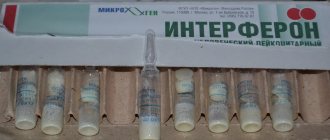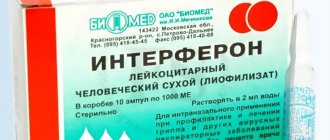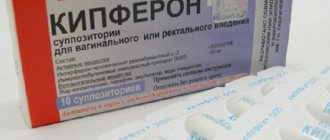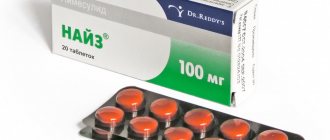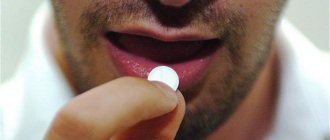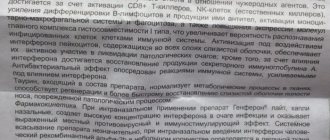Laferon: Properties
The drug has immunostimulating properties and antiviral properties - it is a catalyst for protective antitumor processes occurring in the body; — regulates metabolic processes at the level of humoral and cellular immunity; — activates the activity of natural killer cells and T lymphocytes; — accelerates the process of differentiation of immune cells; — ensures rapid “delivery” of the necessary cells of the immune system to the lesions; - regulates the production of inflammatory mediators; - supports phagocytosis; - reduces the dynamics of inflammation; — exhibits strong antichlamydial activity; — reduces the negative impact of other medications on the human body; - prevents the proliferation of intracellular pathogens, which leads to stopping the lysis of bodies foreign to the body.
Pharmacological authorities
Pharmacodynamics.
Human recombinant interferon alpha-2b is a highly purified protein with a molecular weight of 19300 daltons.
Laferon-PharmBiotek® NASAL to carry out antiviral action. When injected with interferon, viruses (influenza, parainfluenza, adenoviruses, rhinoviruses, reoviruses, etc.) multiply in infected cells, and also produce protection factors that prevent infection other clients. The additional immunomodulatory effect of the drug lies in the activation of phagocytosis, stimulation of the creation of antibodies and lymphokines.
Pharmacokinetics.
I didn’t screw around.
Laferon: indications for use
The use of Laferon for adults and children is indicated to eliminate the following diseases: - chronic form of hepatitis B (acute, severe and moderate forms); - acute form of chronic septic diseases (sepsis); - acute form of various bacterial and viral diseases; — chronic urogenital chlamydia; - damage to the central nervous system; - herpetic infections, including herpes zoster, genital infections, keratouveitis and keratoconjunctivitis; - multiple sclerosis; - papillomatosis of the larynx; - malignant tumors (skin melanoma, eye melanoma, kidney cancer, bladder cancer, breast cancer, Kaposi's sarcoma); - hemoblastoses (myeloid leukemia, hairy cell leukemia, non-Hodgkin lymphoma).
Analogues of the drug
If Laferon is contraindicated for a patient, then it is replaced with functional or structural analogues. The most effective substitutes include the following drugs:
Laferobion
- Laferobion;
- Alfarekin;
- Interferon alpha-2 for the treatment of eye pathologies;
- Okoferon;
- Interferonalfa-nl;
- Amiksin;
- Viferon;
- Nazoferon;
- Kipferon;
- Genferon light;
- Ergoferon;
- Anaferon.
Each of the listed medications has its own side effects and contraindications. Therefore, before starting use, you should consult your doctor. He will assess the possible risk and select an effective treatment regimen.
Laferon: instructions for use
Laferon, instructions for which are contained in each package, can be used in various ways, namely rectally, intranasally, endolymphally, parabulbarly. Quite often the drug is administered to the patient intramuscularly, subcutaneously or intraperitoneally.
Before using the drug Laferon, it is necessary to prepare the solution necessary for use. To prepare a solution with a volume of up to 1 ml, you need to use water for injection, and if there is a need for a larger volume, then use saline solution.
For hepatitis B, Laferon is administered intramuscularly: - for acute form - 1,000,000 IU 2 times a day, for 10 days; - for the chronic form - 3,000,000 - 4,000,000 IU three times a week for 2 months.
For ARVI, intranasal use of Laferon for children is recommended - 20 - 100 thousand IU/ml. For adults, the drug is administered intramuscularly for 3 weeks at 1,000,000 - 3,000,000 IU, or the drug is administered intranasally, 4 - 6 drops 6 - 8 times a day.
In acute pneumonia, it is recommended to use Laferon intramuscularly at a dose of 1,000,000 IU for 5-7 days as part of complex therapy.
For diarrhea in newborns, this drug is used rectally with microenemas of 100 thousand IU for 3 to 7 days.
Intestinal infections in children that occur in an acute form require rectal administration of the drug at 10,000 IU/kg body weight 3 times with an interval of 2 days.
For purulent-septic diseases of the abdominal cavity, the drug is administered intravenously at a dose of 2,000,000 - 4,000,000 IU per day once. The required course of treatment is 12,000,000-1,600,000 IU.
For oncology: for breast cancer, skin melanoma, Kaposi's sarcoma, 3,000,000 IU per day is administered for 10 days. For kidney cancer, Laferon is administered intramuscularly at 1,000,000 IU per day for 10 days. For bladder cancer, intravesical instillations of 5,000,000–10,000,000 IU are performed 3–6 times. For the treatment of ovarian cancer, the drug is used intraperitoneally at a dose of 5,000,000 IU in the drainage after surgery for 5 days. After this, the drug is administered intramuscularly at 3,000,000 IU for 10 days.
For diseases of the central nervous system, Laferon is used intramuscularly at a dose of 1,000,000 IU in complex therapy for 5 to 10 days.
This drug can be used in complex treatment with other medications, with the exception of glucocorticosteroids.
Release form and composition
Dosage form of Laferon: freeze-dried powder (in ampoules or bottles, 1, 5 or 10 pieces in cardboard boxes; 1 or 5 ampoules or bottles complete with a solvent - water for injection, 1 set in a cardboard box).
The active substance is recombinant human interferon alpha-2b, its activity in 1 bottle or ampoule can be: 100 thousand International Units (IU), 1 million IU, 3 million IU, 5 million IU, 6 million IU, 9 million IU and 18 million ME.
Additional components: potassium dihydrogen phosphate, dextran, anhydrous sodium hydrogen phosphate, sodium chloride.
Laferon: price and sale
You can buy Laferon at any pharmacy or using the services offered by online pharmacies. The drug is quite popular, but this does not mean that you can take it without a doctor’s recommendation. Despite the fact that you can buy Laferon only with a prescription, there are a huge number of counterfeits on the pharmacological market and this drug is no exception. When purchasing Laferon, the price of which is basically the same in all pharmacies, you must check for a certificate confirming the conformity of the product.
Side effects
When injecting Laferon, especially at the beginning of the course, the following may often be observed: lethargy, chills, joint pain, increased body temperature, muscle pain and headache. During further treatment, these effects weaken and disappear, and they can also be stopped or significantly reduced by taking 0.5-1 g of paracetamol 30-40 minutes before the injection. With prolonged use, leukopenia and thrombocytopenia may develop, which can be eliminated by lowering the dose.
Symptoms of overdose may include prostration, deep disturbances of consciousness, and lethargy. These conditions are reversible and regress when the drug is discontinued.
Laferon and Transfer Factor
When purchasing Laferon, the price of which is about 1,500 rubles per package containing 10 ampoules, you should not count on quick results. Since one package is enough for only 3-4 days of treatment, and, for example, for oncological diseases, about 10 such packages will be needed, which, accordingly, will increase the cost of treatment to 15,000 rubles. To achieve results, the course of treatment may need to be repeated several times.
The Transfer Factor drug, which performs all the same functions, costs 2000-2700 rubles for a package of 90 capsules. It has a much deeper effect on the body because it affects the human DNA structure. The drug has no contraindications and does not cause side effects. Transfer factor is well tolerated and makes it easier to treat various diseases. The drug has received excellent reviews in the prevention of both viral and infectious diseases, and in the fight against cancer. It allows you to quickly restore the immune system and prevents the emergence of new diseases. If, nevertheless, taking Laferon is necessary, then Transfer Factor, used in conjunction with it, neutralizes the side effects of Laferon.
Terms and conditions of storage
Store in a place protected from light, out of reach of children, at a temperature of 2-8 °C.
Best before date:
- Rectal suppositories – 1 year;
- Lyophilisate for the preparation of solution for injections and nasal drops – 3 years.
After preparation, the injection solution should be used immediately; the solution for intranasal use retains its properties for 1 day if the temperature is maintained (at a temperature of 2-8 °C).
Nasal drops can be stored for 5 days in the refrigerator, at room temperature in a place protected from direct sunlight - 2 days.
Contraindications
Interferon is formed in the human body when an infectious infection occurs. It is strictly forbidden to take the drug if you have an individual intolerance to the active ingredient. The drug in the form of an injection solution should also not be administered to pregnant women. Rectal suppositories Laferon are allowed to be included in the therapeutic regimen in the third trimester of pregnancy. Otherwise, the likelihood of miscarriage will increase significantly. The drug is not recommended for use in children under one year of age. The drug has no other contraindications.
Contraindicated for children under one year of age
Dosage
In ampoules for inhalation, interferon can be supplied in a dose of 1000 international units (IU). The standard package contains 10 pieces (quantity may vary), as well as instructions for use. The drug comes in ampoules in the form of a lyophilisate (dry powdery substance). The dosage of the drug is selected by the doctor based on individual and clinical characteristics.
How to breed?
- You can make a solution in a ratio of 1 to 3: dilute 1 ampoule of interferon in 3 milliliters of saline (in order to dilute the lyophilisate, water for injection is also suitable). Instructions for the frequency of inhalations per day are individual and prescribed by a doctor (most often 2-3 times a day, but not more than 4).
- There is another method to dilute the mixture for inhalation: 3 to 10. 3 ampoules of lyophilized interferon should be diluted in 10 ml of saline solution. Apply 1-2 times a day. The solution is heated to 37 degrees (but no more).
Interferon ampoules should be stored in the refrigerator and also in a place protected from direct light rays. Optimal temperature: from 4 to 10 degrees above zero. It is most acceptable to store the lyophilisate in its original secondary packaging.
How to do inhalations
To achieve the desired therapeutic effect, you should adhere to the procedure technique:
- you need to breathe through your nose (using a mask). The infection often enters through the mucous membrane of the nasal openings, and by inhaling through the nose, both the nasal mucosa and oropharynx are “processed”;
- Inhalation is indicated on an empty stomach or an hour after eating;
- the interval between subsequent procedures is at least 4 hours, and the maximum number of daily applications is up to 4;
- the dosage is prescribed by a physician depending on the severity of the disease, age, body weight and other indicators.
The effect of interferon on the body
Interferons are a group of protein substances, they are released by the body in response to the detection of viral invasions. The antiviral and immunostimulating activity of interferon is very high. There are several types of interferon (depending on the cells that produce it):
| Type | Producing cells |
| Alpha interferon | Produced by leukocytes (protective white blood cells) |
| Interferon beta | Produced by fibrinoblasts (connective tissue cells) |
| Interferon gamma | Produced by macrophages (cells capable of capturing and digesting foreign objects), leukocytes and NK cells (natural killer cells). |
A viral infection, penetrating inside, begins to “capture” healthy cells and actively multiply in them. In response to this, the body secretes interferon, since the viral particle is a foreign object. The mechanism of action of the immune protein is divided into 2 directions:
- Decreased protein synthesis and apoptosis of virus-infected cells. Interferon reduces protein cellular synthesis by activating a specific substance - protein kinase R. As a result, there is a decrease in the level of spread, multiplication and formation of new viral agents. The immune complex also causes the natural destruction (apoptosis) of infected cells by activating the apoptosis protein (p53). Interferons are a kind of “signals” that the damaged cell sends to its neighbors so that they “get ready.”
- Interferons are stimulants that increase the immune response (increase immunity). Interferon gamma, for example, directly stimulates immune cells: macrophages and NK cells.
Fact: to effect an effect on a virus-infected cell, only 1 interferon molecule is enough.
For what diseases is it used?
Interferon for inhalation in a nebulizer is most effective in the early manifestations of infection. The instructions indicate that the drug is used in the case of influenza and other acute respiratory viral infections.
Interferons should be used in the presence of symptoms of viral invasions:
- nasal discharge (with flu, the nasal mucosa most often remains dry);
- pain and discomfort in the throat;
- cough (usually dry and intense, may be accompanied by chest pain);
- chills (increased body temperature);
- frequent sneezing and watery eyes (excluding allergies).
Duration and features of treatment
The use of interferon inhalations, course duration, and dosage are approached on an individual basis.
/center> The duration of one inhalation is 5 minutes (on average), and the course of inhalation procedures itself is about 2 weeks. Treatment features include:
- the treatment has a high preventive effectiveness: inhalations should be done immediately after contact with a patient, visiting places with large crowds of people, hospitals;
- the method must be used in combination with systemic antiviral therapy;
- interferon cannot be used in steam inhalations. Other methods that involve heating the substance to a temperature of more than 37 degrees are also not appropriate;
- Each disease requires its own size of inhaled particles (2, 5, 10 micrometers).
Advice: it is advisable to use interferon intended directly for inhalation, and not for injection.
Method of use for inhalation
It is most effective to use interferon for inhalation for children by spraying particles of 10 micrometers or more. With such dimensions, they “lay down” in an even layer over the surface of the mucosa and attach to it more effectively. Droplets smaller than 5 micrometers do not remain in the upper parts of the respiratory tract, but are deposited in the lower parts. To achieve the required inhalation particle size, a suitable nebulizer is required.
The advantages of a nebulizer include:
- No traumatic effect on the mucous membrane.
- Long-term exposure (compared with the drip method of administration).
- Uniform distribution of inhalate.
- Exact dosage.
- It is possible to breathe using a special mask or mouthpiece (in case of ARVI, it is advisable to breathe through the nose).
- Control of particle sizes (particles of 2 micrometers “reach” the lower “level” of the respiratory tract, 5 micrometers to the bronchi, 10 to the upper sections).
Advice: when purchasing a nebulizer, let your child choose the device he likes (a car, a steam locomotive or another type). This will help turn the inhalation procedure into a game and avoid negative perceptions of the treatment.
